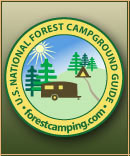Forest Information
The Olympic National Forest is located in northwest Washington and is part of the
Olympic Peninsula. It is surrounded on three sides by salt water and almost completely
surrounds the Olympic National Park. The Forest is comprised of 627,295 acres. There are 26
developed campgrounds of which 16 meet the selection criteria.
Water, fresh and salt, frozen and flowing, falling from the sky as rain and creeping across the
land as fog, has shaped the Olympic National Forest and is a key component to many of its
recreation opportunities. Located on the Olympic Peninsula, the Forest parallels the Pacific
Ocean on the west, Strait of Juan de Fuca on the north, and to the east are Hood Canal and Puget
Sound. Mornings will find the Forest shrouded in gentle fog and rain can fall anytime. This
Forest receives from a couple feet of rain each year on the "drier" eastern side to more than 120-inches on
the "wet" western side. With this much moisture and its temperate climate, where the
temperatures rarely reach above 80 degrees in the summer or below freezing in the winter, the
Olympic National Forest has a lush, green environment for a wide variety of recreational
opportunities. And, it seems, there is a delightful campground near each activity.
The Olympic National Forest surrounds the Olympic National Park and shares many of the
Park's traits. Two they share are great wildlife viewing and temperate rain forests. Large
populations of Roosevelt elk as well as robust populations of black-tailed deer, black bear,
coyote, raccoon, Olympic marmot, and other mammals are found on both the Forest and Park
lands. (Cougars do live on the Olympic Peninsula but sightings are infrequent.) And, there is a
wonderful assortment of feathered friends. The Audubon Society of Washington has published a
map to help birders discover where the more than 200 bird species, found on the Olympic
Peninsula throughout the year, can be seen. Campgrounds such as Hamma Hamma, on the east
side, and Campbell Tree Grove, on the west side, offer a pleasant variety of species and two very
different challenges. While many birds can easily be seen at Hamma Hamma campground,
"birding-by-ear" is the technique needed for success at Campbell Tree Grove. The Audubon
Society has identified 52 other spots, with habitat, species to be seen, access, and more, on their
map (available at their website www.wa.audubon.org).
The Olympic National Forest offers unique hiking experiences in old, dense forests of majestic
conifers. Nowhere is the hiking better than at Falls Creek and Willaby campgrounds. Located
on the banks of Quinault Lake, these campgrounds have easy access to up to ten-miles of
wonderful trails through the Forest's rainforest. (An informative experience is joining the Lake
Quinault Lodge's guided nature walk.) Hikers will find Western Hemlock (easily identified by
their drooping tops), Western Red-cedar (with its stringy bark and small, scaly leaves),
Douglas-fir (the largest tree native to Washington), and Sitka Spruce (identified by its sharp stiff
needles, papery cones and thin scaly bark). Old and grand, these trees provide the Forest's
visitors with many special sights and experiences.
The Sitka spruce is a "hallmark" of the rain forest ecology. Fallen Sitka often become a
"nurse-log," as seen in Klahowya campgrounds. From these nurse-logs, seedlings of trees grow.
Two other hallmarks of a rain forest are a profusion of moss and lichen. Some 200 varieties of
moss might be found in the Olympic National Forest growing on nurse-logs, old tree stumps,
rocks, and just about anything else that stands still for awhile. Sometimes, after the fog has
departed and the sun shines through the droplets of dew on the moss and lichen, the trees appear
to be studded with millions of tiny diamonds.
While visitors to the Olympic National Forest seek out campgrounds like Klahowya, Klahanie,
and Brown Creek for their natural beauty and solitude, others look for specific water-related
activities. Seal Rock campground, located on the beautiful saltwater fjord known as Hood
Canal, has long been popular for the seasonal harvesting of oysters and clams and watching the
passing water traffic. Coho campground, on the banks Wynoochee Reservoir, is a power boater
enthusiast's delight. While Wynoochee Reservoir attracts power boats, the glacier carved Lake
Quinault provides to sail boat enthusiasts, hours of fun.
Although camping, hiking, and fishing are popular, many visitors to the Forest come to enjoy
spectacular views and vistas from their automobiles. It is a short drive, or challenging hike, to
the top of Mt. Walker with its vista of Puget Sound, Seattle, Mr. Rainier, and the Olympic
Range. On the north side of the Forest, auto-bound visitors enjoy Lake Crescent, its mirror-like
surface reflecting the area's breath-taking beauty. The automobile visitors to the Forest's
western side enjoy Hoh Rain Forest, the communities of Neah Bay, Forks, and LaPush, and wild
Pacific Ocean beaches. A special treat is to walk along a Pacific beach with its piles of
driftwood logs and perfectly shaped skipping stones.
Some consider the Olympic National Forest to be only a "gateway to the Olympic National Park"
but, in reality, the Forest is more. The Olympic National Forest offers a wide variety of outdoor
experiences and recreational opportunities in the most unique environment of a lush temperate
rain forest. Perhaps one should think of the Olympic National Park as an extension of all the
Forest has to offer. Come and enjoy the wonders and beauty of this magnificent Forest.
ADDRESSES
SUPERVISOR ADDRESS
1835 Black Lake Blvd. SW
Olympia, Washington 98512
360-956-2402
RANGER DISTRICT ADDRESSES
Hood Canal
295142 Highway 101 S.
P.O.B. 280
Quilcene, Washington 98376
360-765-2200
Pacific - Forks Office
437 Tillicum Lane
Forks, Washington 98331
360-374-6522
Pacific - Quinault Office
353 S. Shore Rd.
Quinault, WA 98575
360-288-2525 |
